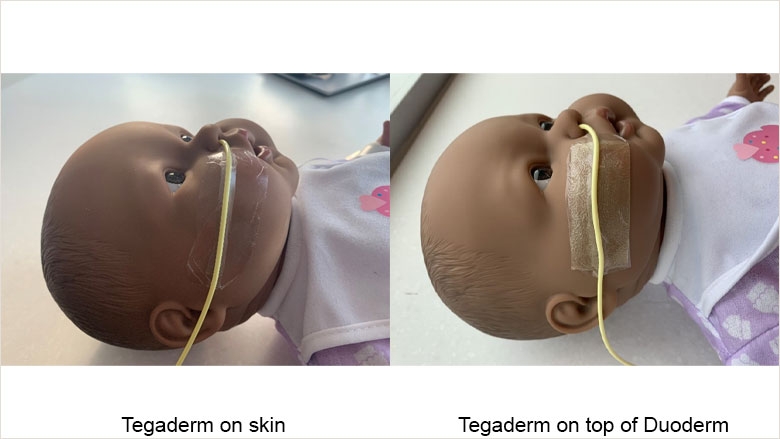Insertion of Nasogastric (NG) Feeding Tube
These instructions are for Children's Hospital of Philadelphia (CHOP) patients who need a feeding tube placed from the nose to the stomach to receive nutrition and medicines directly into the stomach.
Important information about nasogastric (NG) feeding tubes:
-
An NG tube is a thin, soft, flexible tube that is used to deliver liquids to the stomach.
-
The tube is inserted by a caregiver through the nose, down the back of the throat, through the esophagus (food pipe) and into the stomach.
-
The tube can be used for a short period of time or for longer periods, depending on your child's needs.
Preparing for NG tube placement:
-
Wash hands with soap and water or clean with hand sanitizer.
-
Gather supplies:
-
Feeding tube with stylet
-
Oral syringe
-
Water
-
Tegaderm™
-
Duoderm™ (optional)
-
Cavilon™ No Sting Barrier Film - optional for use over 1 month of age
-
Water-soluble lubricant (such as K-Y jelly®)
-
pH strip
-
Scissors
-
Waterproof permanent marker or pen

-
Remove feeding tube from package.
-
Choose a nostril. Choose a different nostril each time you insert the tube.
-
Measure distance to insert feeding tube. Starting with the feeding hole at the end of the tube, measure from the tip of the nose to the bottom of the earlobe, and then to the stomach (halfway between the bottom of the breastbone and the belly button). Mark this point on the tube with a waterproof permanent marker.
-
Prepare supplies that will be used to secure the tube:
-
Measure and cut Duoderm (to protect skin).
-
If using a skin barrier, apply it to the skin where you will be putting the Duoderm.
-
Let the skin barrier dry.
-
Peel backing off the Duoderm to uncover the adhesive.
-
Prepare Tegaderm to keep tube in place. Measure and cut the Tegaderm to size needed.
Instructions for inserting NG tube:
-
Explain to your child what you are going to do. If your child is young, it may be helpful to have someone help you hold them.
-
Place child in an upright position. This may be sitting or with head elevated 30-45 degrees. Your child should not lean forward or tilt their head or neck back.
-
Lubricate the end of the tube by dipping it in water or water-soluble lubricant (such as K-Y jelly).
-
Insert end of the tube into the nostril towards the back of the throat and downward.
-
Thread the tube downward to the marked point on the tube. Encourage your child to swallow.
-
Infants: your baby may suck on a pacifier as you insert the tube.
-
Older children: your child may drink water through a straw as you insert the tube. It is normal for your child to gag when you are placing the tube. Remove the tube if:
-
You meet resistance.
-
Your child starts choking.
-
Your child has trouble breathing.
-
Your child turns bluish gray in color.
-
Your child keeps gagging, coughing, or throwing up after the tube is placed.
-
Your child remains very restless and irritable after placing the tube.
-
Your child's behavior is not normal.

-
Once the tube is in place, secure it with the Tegaderm. Place the Tegaderm as close to the nose as possible.
Instructions for confirming NG tube placement:
Once the tube is secured, check for proper tube placement.
-
Attach an oral syringe to the medicine port. Make sure the stylet is firmly in the main feeding port.
-
Slowly pull back on the plunger of the syringe to get stomach contents. Completely cover the test area on the pH strip with the fluid.
-
Check the pH by comparing the pH strip with the color scale. Gastric (stomach) pH should be 1-5.
-
Once you have confirmed that the tube is in the stomach: make sure the stylet is firmly in the feeding port. Attach an oral syringe with 5ml of water to the medicine port and push the water through the tube. The water activates a lubricant on the inside of the tube so the stylet can easily be removed.
-
Remove the stylet and close the feeding port. Save the stylet. If the tube comes out, you will need the stylet to reinsert the tube. Do not reinsert the stylet while the feeding tube is in your child. Do not use the stylet if it is bent.
-
Write down the number marking where the tube is secured.
-
Change the tube to a new one if there is a leak in the tube or you can no longer read the markings on the tube. If you are reusing a tube:
-
Clean the tube by rinsing the tube with warm water only. Air dry on a paper towel.
-
Remeasure the tube.
-
Clear the tube by flushing with 3-5ml of air.
-
Coat the stylet with water-soluble lubricant before placing it in the tube.
-
Discard the tube if the stylet no longer reinserts properly or you are unable to get the tube clean or it has an odor.
-
If your child's nose or face becomes irritated, call your healthcare provider.
Instructions for care of NG tube:
-
Check the pH before giving anything through your child's feeding tube, such as medicines or formula.
-
Always check that the mark on your child's feeding tube has not changed. If the mark has moved, reposition the tube and check your child's pH.
-
Always check the placement (pH) of your child's feeding tube if they are not tolerating feeds or medicine, or you think something is wrong.
-
Always have a backup NG tube available. Contact your home care provider when running low on supplies and when you insert your last NG tube.
Reviewed on October 17, 2022, by Carly Ehritz, MSN, RN